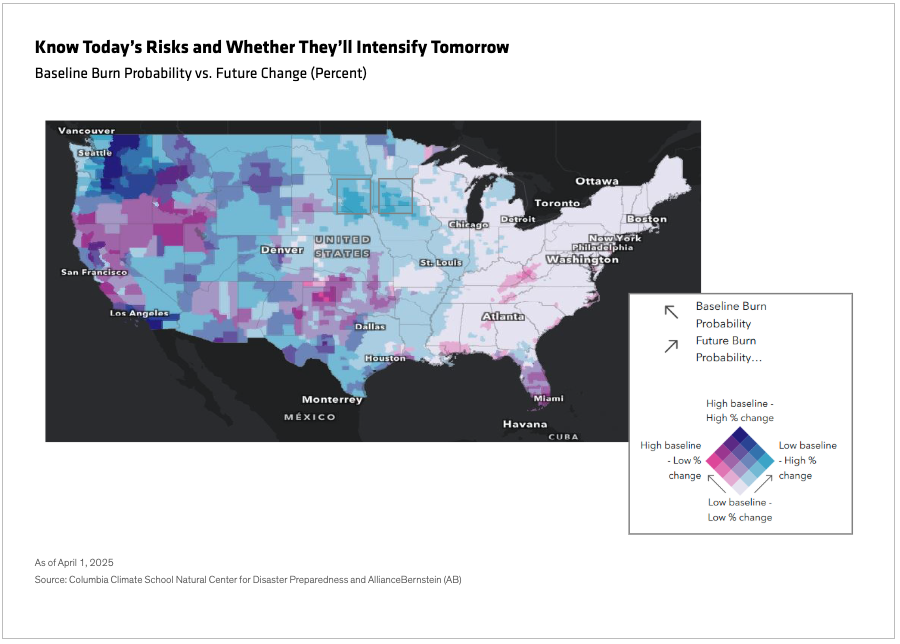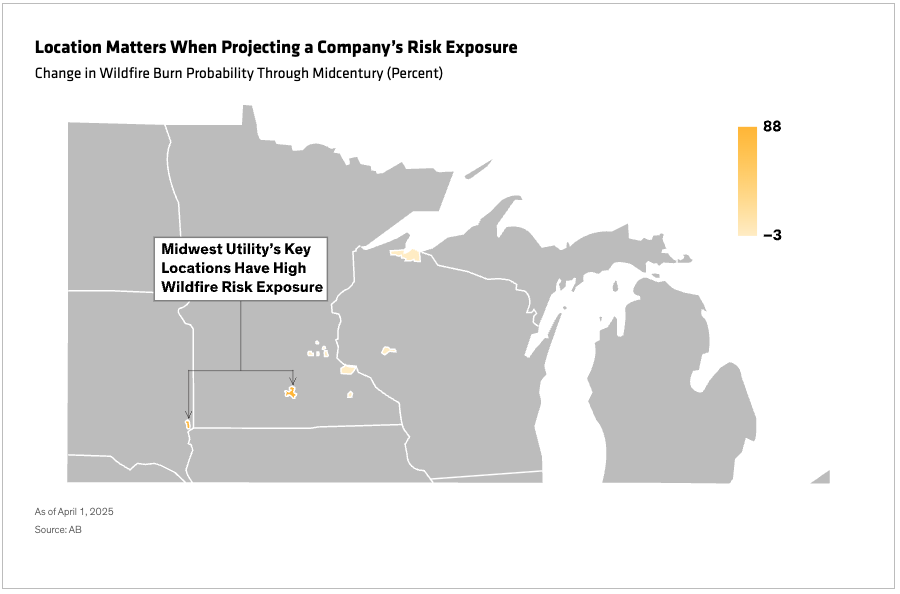AB: Can Tomorrow’s Natural Hazards Inform Today’s Investment Decisions?
Published 06-18-25
Submitted by AllianceBernstein

Patrick O'Connell, CFA| Director—Responsible Investing Portfolio Solutions and Research
John Huang, CFA| Director of Responsible Investments, Data and Technology—Responsibility
Kathleen Dumes, CFA| Research Analyst—Responsible Investing Portfolio Solutions and Research
New research connects intensifying natural perils to their future implications for asset classes.
When it comes to measuring our vulnerability to nature's extremes, investors often lean on past data and simply assume that risks will rise. But new groundbreaking research has removed considerable guesswork, particularly among four key natural hazards facing the world this century.

Global Experts Unite to Predict Natural Hazard Threat Levels
New projections from Columbia Climate School build on its pioneering Natural Hazards Index (NHI), launched in 2016 to assess risk-level exposure from floods, drought and a dozen other extreme events nationwide. In 2023, we partnered with the university on a version 2.0 release, which includes an interactive map of natural hazard exposures for thousands of individual US communities.
2025’s upgrade broadens Columbia’s and AB’s collaboration among leading academic and public institutions, including NASA. Applying the latest weather science, climate research and sophisticated modeling, NHI 3.0 can now project the relative location, trajectory and magnitude of the four natural hazards it tracks at midcentury and end-of-century.
The NHI 3.0 not only tells us the ways a particular hazard has evolved, but also how it’s likely to evolve in the future. Wildfires, for example, have increased in frequency and intensity. New data not only predicts fires to worsen where they’re already commonplace, such as Southern California and Washington State, but also in areas where incidences are currently rare, like Minnesota and South Dakota (See display above).
Newly forecasted tornado patterns are alarming too, with more outbursts likely stretching beyond the Midwest “alley” and much further east.
The NHI also anticipates where hazards will intersect. Sometimes, a disaster ebbs because of an equally disruptive event. The index shows that Louisiana, for instance, will likely suffer fewer wildfires but ties that to expected more frequent hurricanes, which lead to more flooding.

Tying Natural Hazard Vulnerabilities to Investable Assets
Columbia Climate School’s new data provide essential inputs for planning disaster responses and anticipating hazards’ long-range effects on people, the environment and economies. We believe it also can help investors see better around corners—which is particularly useful as climate change grows more unpredictable and hyperphysical.
With this in mind, we are incorporating key components of NHI 3.0 into our proprietary Physical Hazard Investment Risk (PHIR) tool, which overlays a financial element for each NHI hazard across more than 3,100 US counties. The expanded research now helps PHIR factor future local risk exposures to wildfires, hurricanes, tornadoes and rising sea levels in the US—considered the top four natural threats through 2050.
As an investment tool, the PHIR can assess hazard-risk exposure across municipal bonds and residential mortgage-backed securities. After all, homes, schools, hospitals, power plants and airports are all location specific, which means issuers and lenders are exposed to distinctly local trends in climate change.
Active equity investing can also benefit from the PHIR’s expanded data. Companies of all stripes can be just as exposed to local hazards—if not now, then in the coming decades. A company’s degree of risk could be exponential, since many operate in multiple locations that face elevated risk.
Wildfire projections offer a prime example of how a single company can reveal several risk profiles. A large utility with facilities in Minnesota and South Dakota may be situated in low-risk areas currently. But the wildfire outlook changes dramatically by midcentury. This region shows an increase in wildfire exposure of 88% (See display above), a material factor that we believe the company—and those in similar situations—should address. In this case, we engaged the company’s leadership about applying lessons learned from its properties in wildfire-prone Colorado to their Midwest operations.
The Local Threats Are Clear, but Not Always Observed
Not all risk scenarios will be as easily navigated. Add the rising threat of higher sea levels, tornadoes and hurricanes, and the future strain on businesses and industries is dire yet actionable. Investors don’t always take notice, however. Our expanded PHIR data set helps identify potentially mispriced investment opportunities where hazard exposure isn’t yet fully factored into market valuations.
Tomorrow's hazards won’t look like yesterday's, but they can inform today's decisions. Locally mapping future natural hazard intensity and addressing its implications will be important steps to dealing with disasters as the century plays out. We think the new predictive analysis will likely save lives and livelihoods. But this forward-looking lens can also help investors understand what natural hazard exposure means for physical assets, while motivating companies and bond issuers to offset such risks on their bottom lines.
The views expressed herein do not constitute research, investment advice or trade recommendations and do not necessarily represent the views of all AB portfolio-management teams. Views are subject to revision over time.
Learn more about AB’s approach to responsibility here.

AllianceBernstein
AllianceBernstein
AllianceBernstein (AB) is a leading global investment management firm that offers diversified investment services to institutional investors, individuals, and private wealth clients in major world markets.
To be effective stewards of our clients’ assets, we strive to invest responsibly—assessing, engaging on and integrating material issues, including environmental, social and governance (ESG) considerations into most of our actively managed strategies (approximately 79% of AB’s actively managed assets under management as of December 31, 2024).
Our purpose—to pursue insight that unlocks opportunity—describes the ethos of our firm. Because we are an active investment manager, differentiated insights drive our ability to design innovative investment solutions and help our clients achieve their investment goals. We became a signatory to the Principles for Responsible Investment (PRI) in 2011. This began our journey to formalize our approach to identifying responsible ways to unlock opportunities for our clients through integrating material ESG factors throughout most of our actively managed equity and fixed-income client accounts, funds and strategies. Material ESG factors are important elements in forming insights and in presenting potential risks and opportunities that can affect the performance of the companies and issuers that we invest in and the portfolios that we build. AB also engages issuers when it believes the engagement is in the best financial interest of its clients.
Our values illustrate the behaviors and actions that create our strong culture and enable us to meet our clients' needs. Each value inspires us to be better:
- Invest in One Another: At AB, there’s no “one size fits all” and no mold to break. We celebrate idiosyncrasy and make sure everyone’s voice is heard. We seek and include talented people with diverse skills, abilities and backgrounds, who expand our thinking. A mosaic of perspectives makes us stronger, helping us to nurture enduring relationships and build actionable solutions.
- Strive for Distinctive Knowledge: Intellectual curiosity is in our DNA. We embrace challenging problems and ask tough questions. We don’t settle for easy answers when we seek to understand the world around us—and that’s what makes us better investors and partners to our colleagues and clients. We are independent thinkers who go where the research and data take us. And knowing more isn’t the end of the journey, it’s the start of a deeper conversation.
- Speak with Courage and Conviction: Collegial debate yields conviction, so we challenge one another to think differently. Working together enables us to see all sides of an issue. We stand firmly behind our ideas, and we recognize that the world is dynamic. To keep pace with an ever changing world and industry, we constantly reassess our views and share them with intellectual honesty. Above all, we strive to seek and speak truth to our colleagues, clients and others as a trusted voice of reason.
- Act with Integrity—Always: Although our firm is comprised of multiple businesses, disciplines and individuals, we’re united by our commitment to be strong stewards for our people and our clients. Our fiduciary duty and an ethical mind-set are fundamental to the decisions we make.
As of December 31, 2024, AB had $792B in assets under management, $555B of which were ESG-integrated. Additional information about AB may be found on our website, www.alliancebernstein.com.
Learn more about AB’s approach to responsibility here.
More from AllianceBernstein

